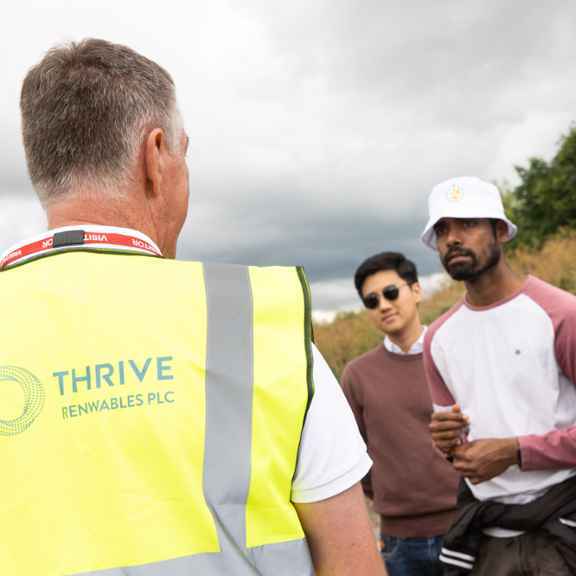Thrive's portfolio of 22 wind, solar and hydro projects generated 134,000 MWh of clean electricity in 2022 (enough to power the equivalent of over 38,000 average UK homes) and avoided the equivalent of 58,000 tonnes of CO2 emissions.
But the team aren’t stopping there. Beyond funding new clean energy projects, we explore just some of the ways Thrive Renewables is prioritising its environmental and social impact – from repurposing old turbine blades to providing energy efficiency grants and training to the local communities living close to its sites.
Helping people take ownership of their local energy supply
Something that sets Thrive apart is how it enables communities to build, own and operate their own wind and solar projects. In fact, the company has provided over £20 million to community-led projects, including £4 million in funding for Scottish based group, ATTIX CIC, so that it can move forward with its plans to build the country’s first subsidy-free, 100% community owned onshore wind turbine just outside Kilbirnie, Scotland.
Once operational, the turbine will have the capacity to generate 7,839 MWh of clean electricity per year, the equivalent of powering 2,234 average UK homes, and will also deliver 3,324 tonnes of carbon emissions reductions annually. Because it’s owned by the community, profits from electricity sales will be reinvested back into the local area – which could include reinvigorating local sports and recreational facilities or giving a new lease of life to the Knox Institute building – a one-time important community hub.
Repurposing old turbine blades into community bus shelters
It’s one thing operating a clean energy project but what happens to the infrastructure when it comes to the end of its life and cannot be reused? Thrive is leading the way when it comes to supporting a circular economy, recently working with Scottish start-up ReBlade to repurpose the blades from its 22-year-old Sigurd wind turbine on Orkney.
After two decades, you can only imagine how productive a life these blades have had. They have generated over 88 GWh of clean electricity and travelled just over eight million miles in total – the equivalent to making a quarter of a million return journeys from Thrive’s office in Bristol to its Sigurd turbine in an electric vehicle. Unsuitable for reuse, the blades will instead be repurposed and turned into useful items for businesses, councils and communities – from sustainable bike shelters and EV charging stations to bespoke dining tables.
Fighting fuel poverty with energy efficiency training
To help protect people against the ongoing energy and cost of living crises, Thrive has made energy essentials training available to the local communities that apply for its Community Benefit Programme, which is delivered by national energy charity, Centre for Sustainable Energy (CSE). Topics covered will include fuel poverty awareness and basic energy advice, community approaches to tackling fuel poverty and energy efficiency in community buildings.
This is being offered alongside energy efficiency grants so that important social spaces like village halls, community centres and church halls can make improvements (like installing window and roof insulation) ahead of the winter months.
Protecting local biodiversity
We know that climate change and biodiversity loss go hand in hand. Like us, Thrive takes its environmental impact extremely seriously which is why, when it invests in a new project, it also commits to conserving and enhancing the site’s biodiversity. Each wind, solar and storage site has a biodiversity management plan in place to support nature and wildlife locally.
The measures the company has put in place at its 20MW battery storage project at Feeder Road in Bristol are an example of how it prioritises the local wildlife during the early stages of development. With support from a landscape architect and ecologist, Thrive focused on providing a variety of animals with more places to nest and shelter. As well as installing several bird, bat and invertebrate boxes (and a hedgehog house!), it has planted native trees and ferns, hedgerows and grassland which will deliver year-round benefits once established.




Thanks for joining the conversation.
We've sent you an email - click on the link to publish your post.